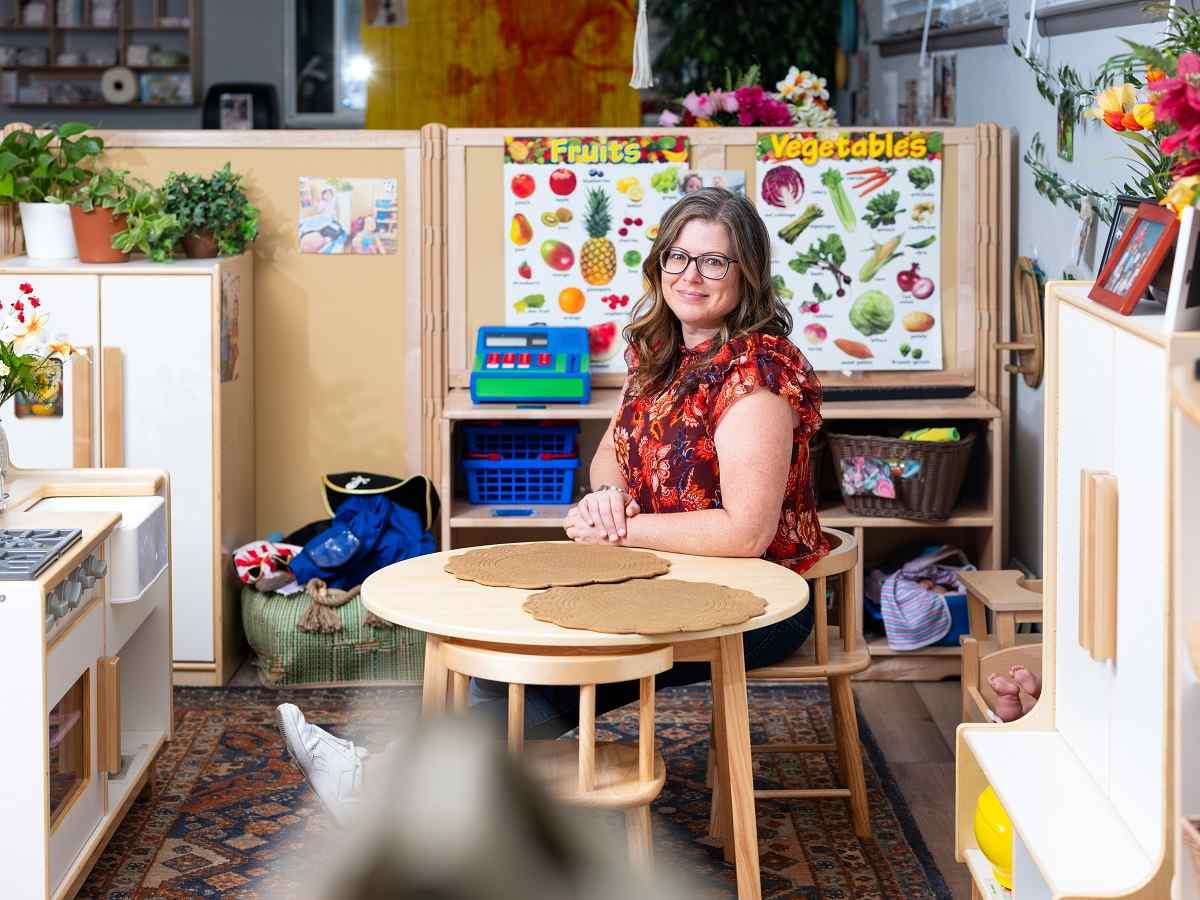
Ryan and Kayla Frost at their home in Washoe Valley, Nev., on Thursday. The couple struggled to find affordable day care for their children.

Christine McNally, owner of Under the Magic Pine Tree, a Reggio-inspired learning center for infants to kindergarten age, in Reno, Nev., on Sept. 14.

James and Sonia Kretschmer with their three children at their home in Reno, Nev.
12:49 JST, September 24, 2024
RENO, Nev. – Kayla and Ryan Frost were desperate. Every local day care was full. Nannies were booked. Neither could quit their job. So they patched together a solution: paying their dog sitter to watch their 3-month-old daughter.
But the dog sitter, who was great with their German shepherd mix, wasn’t the right fit for their infant. And because of her $25 hourly rate, the Frosts could afford care for only a couple of days a week.
“A few weeks in, we realized, ‘This is not working. We need more help than this,’” said Kayla Frost, 35. “We limped along for half a year. We stopped working as much. We were exhausted. It really took a toll.”
The shortage of child care is a national problem, but in Nevada, it’s approaching a crisis. The state ranks among the worst in the country with almost three-quarters of young children lacking access to licensed care, according to the governor’s office. The shortfall spans every county in this swing state and is driving up day-care costs when parents are already under financial strain because of inflation.
Along with housing prices, child-care costs are among the last remnants of inflation haunting Americans – a point that Biden administration economists have conceded. Although gas, cars and groceries, including bread, bacon and vegetables, have all become cheaper in the past year, day-care costs have risen 6.2 percent – more than double the rate of overall inflation.
Those high costs are increasingly factoring into how people plan to vote in the presidential election, just over six weeks away. More than one-third of mothers who are registered to vote said they worry “a lot” about affording child care, according to a recent KFF poll.
Vice President Kamala Harris has made the “care economy” a cornerstone of her platform, vowing to permanently increase the child tax credit, add a one-time $6,000 credit for newborns and cap child-care costs at 7 percent of a working family’s income. Former president Donald Trump has also said he would consider expanding the child tax credit, though he has not offered further details. Meanwhile, his running mate, JD Vance, has argued that children would benefit from a stay-at-home parent, suggesting families should rely more on “grandma and grandpa” to save on child care.
“Child care is a huge piece of the puzzle that families, especially in Nevada, have to put together every day just to participate in the labor force,” said Caitlin Saladino, a director at Brookings Mountain West, a partnership between the D.C. think tank and the University of Nevada at Las Vegas. “This is a nonpartisan issue – parents are having a really hard time, and it’s becoming an even bigger focus as we approach the election.”
In interviews with about two dozen working parents in closely divided Washoe County, all cited finding and paying for child care as among their top concerns. More than half said inadequate child care had forced them to cut their hours at work, at hotels, hospitals, factories and in law enforcement. Some have quit.
“I’ve looked around for years and have not been able to find anything that’s affordable, at all,” said Meghan Archambault, an administrative assistant who pays their mother $500 a month to watch their 6-year-old twins after school and is planning to vote for Harris. “We live paycheck to paycheck and go to food banks every week. The cost of raising a family is a major concern for us.”
Paying for child care is a particular struggle in Reno, a 24-hour casino town where child care needs spill over into nights and weekends. The area has among the least affordable child care in the country, with day care eating up almost 20 percent of a typical family’s income, Labor Department data shows.
And while the state has benefited from a burst of pandemic-era federal spending, including $571 million in child-care funding alone, that money runs out this month. Child-care providers say it will be even tougher for them to operate, and for families to afford care, after that.
“The last few years have been a complete roller coaster, but government money has helped stabilize the system,” said Christine McNally, a child-care provider who recently expanded from one center to three. “But now it feels like we’re going back to wondering what happens next.”
More than two-thirds of families at McNally’s Reno facility rely on subsidies. Many also benefited from the Biden administration’s expanded child tax credit, which gave families as much as $3,600 per child in 2021, up from $2,000, and temporarily lifted millions of children out of poverty. Subsequent efforts by the White House to extend those credits have fizzled in Congress.
For families in Reno, strengthened tax credits would go a long way. Sonia and James Kretschmer spend much more on child care than they do on their mortgage. The couple, both high school teachers, pay $2,700 a month for preschool for their 3-year-old twins and before- and after-school care for their 8-year-old son. They’ve borrowed against their home, taken on extra work coaching soccer and bartending, and racked up credit card debt to make ends meet.
“I’m not a Democrat or a Republican. I believe in looking at the issues,” said Sonia Kretschmer, 38, a social studies teacher who is leaning toward voting for Harris. “What is going to help my family? What is going to help my community? And right now, it’s about child care.”
The Frosts, who briefly paid their dog sitter $150 a day for help, finally found a long-term solution last month: an in-home day care that charges $250 a week. Their daughter is happy, they said. And Kayla, an insurance agent, and Ryan, a powersports mechanic, are more productive at work. The couple are planning to vote for Trump and are hoping tax cuts will help cover the cost of food, gas – and child care.
“We solved one problem when we found this day care,” Kayla Frost said. “But now we’re focused on how we’re going to pay for it. It’s a thousand-dollar expense we didn’t have before.”
Many parents in Reno said campaign promises from either party had been slow to break through. They were disheartened that child care wasn’t discussed in the recent debate between Harris and Trump. When the topic came up in the June debate between President Joe Biden and Trump, neither candidate offered much of a plan.
“That was really devastating to me, as a mom – to see [Biden and Trump] talk more about golf than they did about child care,” said Laura Mastin, 38, a tech worker with two young children. “For so many families, child care is the biggest day-to-day stressor.”
Mastin, a longtime Democrat, said she is more hopeful now that Harris and running mate Tim Walz, a former high school teacher, have secured the party’s nomination. Both have championed child-care affordability as a key part of their platform.
“We believe in a future where every person has … affordable health care, affordable child care, paid leave,” Harris said in a speech this summer.
When asked this month how he would enact specific policies to help parents with child care, Trump said it was “a very important issue” before adding that it paled in comparison to the “trillions” he could add to the U.S. economy by levying new tariffs on imports. “As much as child care is talked about as being expensive, it’s relatively speaking not very expensive compared to the kind of numbers we’re taking in,” he said at an event hosted by the Economic Club of New York.
The Biden White House has acknowledged that child-care prices are one of “two areas of critical unfinished business,” as Jared Bernstein, chair of the Council of Economic Advisers, put it this summer. He placed the blame on Congress, saying it had nixed the administration’s plans to address the problem, including $15 billion to boost child-care subsidies and fund new preschools.
“There is every reason for these to be bipartisan policies,” Bernstein said during a presentation at EPI Action in July. “I don’t care if you’re in a red, blue or purple state, you need a lot more affordable housing and child care.”
Although child care has been bubbling up on the political stage, some families say they haven’t spent much time following the candidates’ platforms. “Honestly, it’s a lot to keep up with,” said Alyssa Felix, 21, who hasn’t voted before and isn’t sure she will this year.
Felix works six days a week making drawers at a furniture warehouse and often relies on her sister or her sister’s mother-in-law to care for her daughters, ages 2 and 3. Even then, Felix says there are many days when she has to leave work early or call out altogether because of child-care issues.
One of Felix’s children recently got into a federally funded Early Head Start program, but it covers only three hours a day, Monday through Thursday, adding another scheduling complication to work around.
“Would I like day care? Of course,” said Felix, who has been on a waiting list for subsidized child care for months. “But right now there’s no way I could afford it.”
Almost 70,000 Americans said they missed work last month because of child-care problems, a figure that has remained elevated since the early shock of the pandemic, according to Labor Department data. Working mothers in particular were almost three times as likely as fathers to take time off for child care last year.
Misty Grajeda, 29, recently quit her job scheduling health-care appointments in Reno, after it became clear there was no way she could care for her infant while working full-time from home. She managed for three months, muting the phone when her baby was crying and rocking her with one arm while typing with the other. But the arrangement left her frazzled, and paid care was out of the question on her $18-an-hour wage.
These days, she spends a few hours delivering for DoorDash and Instacart in the evenings, after her husband finishes his job painting houses. She can’t take on a steady job until she makes it off the state’s wait list for subsidized care.
“I want to look for a full-time job, but day care is very expensive. I can’t afford it,” said Grajeda, who voted for Biden in 2020 but plans to vote for Trump this time because of her family’s financial struggles.
“Honestly, for us,” she said, “the economy was better when Trump was president.”
"News Services" POPULAR ARTICLE
-

American Playwright Jeremy O. Harris Arrested in Japan on Alleged Drug Smuggling
-

Taiwan President Shows Support for Japan in China Dispute with Sushi Lunch
-

Japan’s Nikkei Stock Average as JGB Yields, Yen Rise on Rate-Hike Bets
-

Japan’s Nikkei Stock Average Licks Wounds after Selloff Sparked by BOJ Hike Bets (UPDATE 1)
-

Japanese Bond Yields Zoom, Stocks Slide as Rate Hike Looms
JN ACCESS RANKING
-

Japan’s Hopes for Seafood Exports Shot Down in China Spat
-

Keidanren Chairman Yoshinobu Tsutsui Visits Kashiwazaki-Kariwa Nuclear Power Plant; Inspects New Emergency Safety System
-

Japan to Charge Foreigners More for Residence Permits, Looking to Align with Western Countries
-

Japan Exports Rise in October as Slump in U.S. Sales Eases
-

Govt Aims to Expand NISA Program Lineup, Abolish Age Restriction



























